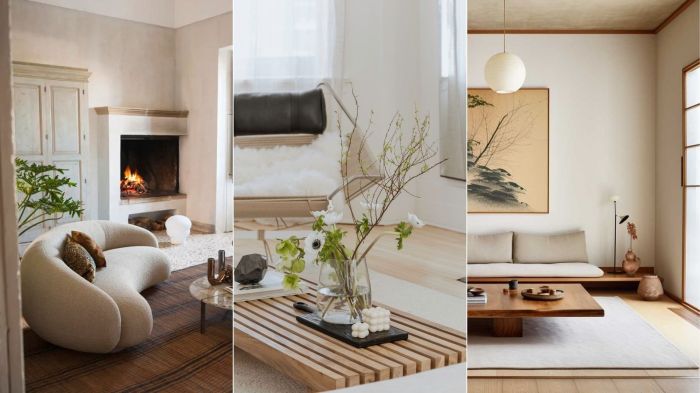Japandi living room sets the stage for this enthralling narrative, offering readers a glimpse into a story that is rich in detail with casual formal language style and brimming with originality from the outset.
As we delve into the intricacies of Japandi design, we uncover a harmonious blend of Japanese minimalism and Scandinavian simplicity, creating a space that exudes elegance and tranquility.
Japandi Living Room Design

Japandi style in interior design is a harmonious blend of Japanese minimalism and Scandinavian coziness. It combines the clean lines, neutral colors, and natural elements of Scandinavian design with the simplicity, functionality, and craftsmanship of Japanese aesthetics.
Key Elements of a Japandi Living Room
A Japandi living room typically features:
- Neutral color palette with pops of muted colors
- Minimalist furniture with clean lines
- Natural materials like wood, bamboo, and stone
- Functional and decluttered space
- Cozy textiles such as wool and linen
Comparison with Other Interior Styles
When compared to other interior styles:
- Minimalism: Japandi adds warmth and coziness lacking in pure minimalism.
- Scandinavian: Japandi incorporates Japanese elements for a unique twist on Scandinavian design.
- Hygge: Japandi embraces the concept of coziness and comfort similar to Hygge but with a more minimalist approach.
Color Palette and Materials
In a Japandi living room, the color palette is typically a harmonious blend of neutral and earthy tones, creating a sense of tranquility and simplicity.
Use of Natural Materials
Natural materials play a significant role in Japandi design, with a focus on sustainability and authenticity. Wood, particularly light oak or dark walnut, is commonly used for furniture and flooring to bring warmth and texture to the space. Bamboo is another popular choice for accessories and decor elements, adding a touch of nature and elegance.
Incorporating Earthy Tones and Minimalistic Colors
To achieve the Japandi aesthetic, incorporate earthy tones like beige, taupe, and olive green for a calming atmosphere. Pair these earthy hues with minimalistic colors such as white, black, or grey to maintain a clean and uncluttered look. Consider adding pops of color through soft furnishings or artwork to create visual interest while still keeping the overall design balanced and serene.
Furniture and Layout
When selecting furniture pieces for a Japandi living room, it is essential to focus on simplicity, functionality, and natural materials. The furniture should have clean lines, minimalistic design, and a combination of Japanese and Scandinavian influences.
Selecting Furniture Pieces
- Opt for low-profile furniture with clean lines and minimal ornamentation.
- Choose furniture made from natural materials like wood, bamboo, or rattan.
- Consider multipurpose furniture pieces that offer both functionality and aesthetic appeal.
- Incorporate elements of Japanese and Scandinavian design, such as shoji screens or cozy Scandinavian rugs.
Layout Principles
- Embrace the concept of "Ma," which is the Japanese philosophy of creating space and emptiness to enhance the overall design.
- Keep the layout open and uncluttered to promote a sense of tranquility and calmness.
- Arrange furniture to allow for natural light to flow freely throughout the space.
- Create zones within the living room for different activities, such as lounging, dining, or reading.
Balance Between Functionality and Aesthetics
- Ensure that each furniture piece serves a practical purpose while contributing to the overall aesthetic of the room.
- Focus on quality over quantity when selecting furniture, prioritizing pieces that are both functional and visually appealing.
- Strive for a harmonious balance between the Japanese emphasis on simplicity and the Scandinavian focus on comfort.
Decor and Accessories
When it comes to Japandi living room decor, it's all about blending Japanese and Scandinavian influences to create a harmonious and minimalistic space. Decor items like plants, ceramics, and textiles play a crucial role in adding warmth, texture, and a touch of nature to the room.
Incorporating Japanese and Scandinavian Influences
To incorporate Japanese influences, consider adding elements like bonsai trees, bamboo accents, shoji screens, or traditional Japanese pottery. These items bring a sense of tranquility, simplicity, and natural beauty to the space.
On the other hand, Scandinavian decor can be introduced through light wood furniture, cozy textiles like wool or sheepskin throws, and clean lines. This aesthetic emphasizes functionality, comfort, and a sense of hygge, or coziness.
Decluttering and Minimalism
- Embrace minimalism by decluttering the space and focusing on quality over quantity. Keep surfaces clear and opt for simple, streamlined furniture pieces.
- Choose decor items mindfully, selecting pieces that serve a purpose and add to the overall aesthetic of the room.
- Incorporate natural elements like plants and wooden accents to bring a sense of tranquility and connection to the outdoors.
- Keep color palettes neutral with pops of muted tones or earthy hues to maintain a sense of calm and balance in the room.
Last Recap
In conclusion, Japandi living rooms embody a unique fusion of cultures and design philosophies, resulting in a space that is both functional and aesthetically pleasing. Embracing the principles of decluttering, natural elements, and a muted color palette, Japandi style offers a timeless elegance that resonates with modern sensibilities.
Helpful Answers
What makes Japandi design unique?
Japandi design combines the best of Japanese minimalism and Scandinavian simplicity, creating a harmonious balance between function and aesthetics.
How can I incorporate earthy tones into my Japandi living room?
You can use earthy tones like beige, brown, and olive green in your decor elements such as rugs, cushions, and artwork to add warmth and depth to your Japandi space.
What furniture pieces work best in a Japandi living room?
Opt for furniture pieces with clean lines, natural materials, and a minimalist design to complement the Japandi aesthetic. Think of pieces that prioritize both form and function.
